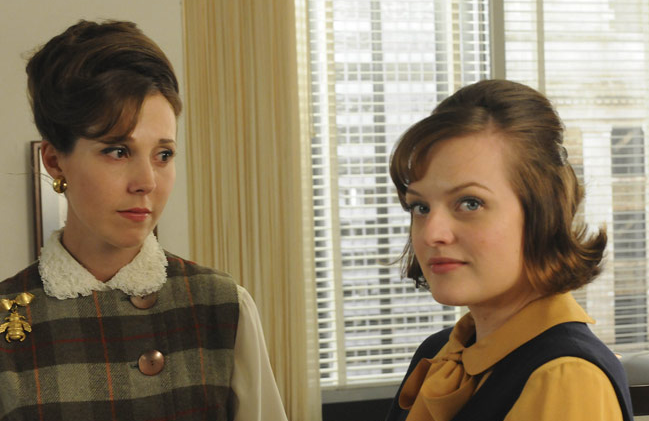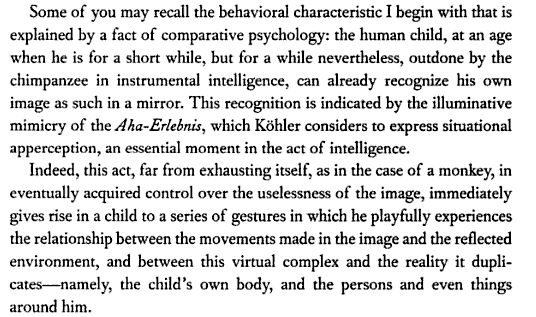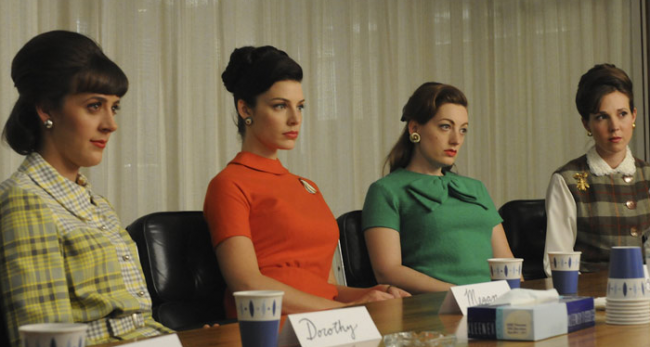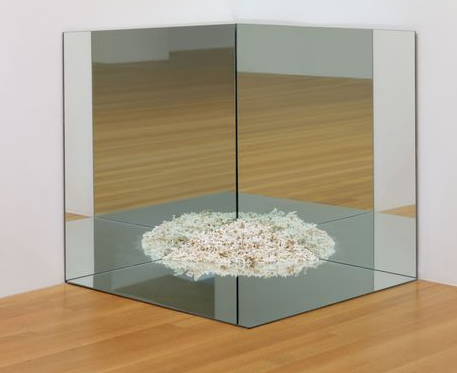Footnotes of Mad Men: The Two-Way Mirror and Social Anomie

“This is the most underwhelmed I’ve felt on first viewing in quite some time,” begins the recaplet of last night’s “Mad Men” on Television Without Pity this morning. I find that astonishing. Maybe insane! Last night’s episode, the first to be directed by John “Roger Sterling” Slattery, was an incredibly nuanced, thoughtful and intricate construction. There are the mirror babies of Pete Campbell; the mirrored women of Don Draper and the mirrored sexual choices of Don Draper’s past and present secretaries; the mirrored salesmen of different firms, sitting across from each other at lunch. We haven’t seen such careful opposition and careful organization since the season two finale, in which we dealt with Betty Draper’s rather unwanted pregnancy (she sought to ‘deal with it’ by horseback riding) while Peggy at last told dreadful, rapey suck-up Pete Campbell that she’d had his baby.
â — Jacques Lacan, at the Fourteenth International Psychoanalytical Congress on August 3, 1936, first presented on the “mirror stage.”

While the idea of this enlightenment supposedly occurs before the age of 18 months, well, we’re not always all grown up, or not narcissists, are we?
“Mad Men” is built around moments of seeing oneself in other people, with understanding or with misidentification, resulting in horror. Picture Peggy blowing up at Don’s poor discarded sex-toy secretary, who views Peggy as a former Don cast-off. Peggy is revolted, somewhat unfairly-although, yes, this act of assumption strips Peggy of all her hard-won authority and competence. Not everyone sleeps with the boss, sister! Particularly when sleeping with the boss, contra Helen Gurley Brown, seems like the fast ticket to lack of success, not your own office.
â — While Don isn’t wrong entirely to berate our lady of the focus group (though he is doing it for the wrong reasons, his wounded male hubris), he’s wrong about their efficacy and use for good.

Robert K. Merton, one of the most influential sociologists of the 20th century, whose coinage of terms like ‘’self-fulfilling prophecy’’ and ‘’role models’’ filtered from his academic pursuits into everyday language, died yesterday….. His studies on an integrated community helped shape Kenneth Clark’s historic brief in Brown v. Board of Education, the Supreme Court case that led to the desegregation of public schools.
And:
One early example of such illuminating insight appeared in a paper called ‘’Social Structure and Anomie’’ that he wrote as a graduate student at Harvard in 1936 and then kept revising over the next decade.
Mr. Merton had asked himself what it was that brought about anomie, a state in which, according to Mr. Durkheim, the breakdown of social standards threatened social cohesion. In a breakthrough that spawned many lines of inquiry, Mr. Merton suggested that anomie was likely to arise when society’s members were denied adequate means of achieving the very cultural goals that their society projected, like wealth, power, fame or enlightenment.
Look how far we haven’t come!
â — Malcolm X was shot on February 21, 1965, placing “Mad Men” now at the end of that month. In May of 1963, Playboy published an interview with Malcolm X, conducted by Alex Haley.
PLAYBOY: What is the ambition of the Black Muslims?
MALCOLM X: Freedom, justice and equality are our principal ambitions. And to faithfully serve and follow the Honorable Elijah Muhammad is the guiding goal of every Muslim. Mr. Muhammad teaches us the knowledge of our own selves, and of our own people. He cleans us up−−morally, mentally and spiritually−−and he reforms us of the vices that have blinded us here in the Western society. He stops black men from getting drunk, stops their dope addiction if they had it, stops nicotine, gambling, stealing, lying, cheating, fornication, adultery, prostitution, juvenile delinquency. I think of this whenever somebody talks about someone investigating us. Why investigate the Honorable Elijah Muhammad? They should subsidize him. He’s cleaning up the mess that white men have made. He’s saving the Government millions of dollars, taking black men off of welfare, showing them how to do something for themselves. And Mr. Muhammad teaches us love for our own kind. The white man has taught the black people in this country to hate themselves as inferior, to hate each other, to be divided against each other. Messenger Muhammad restores our love for our own kind, which enables us to work together in unity and harmony. He shows us how to pool our financial resources and our talents, then to work together toward a common objective. Among other things, we have small businesses in most major cities in this country, and we want to create many more. We are taught by Mr. Muhammad that it is very important to improve the black man’s economy, and his thrift. But to do this, we must have land of our own. The brainwashed black man can never learn to stand on his own two feet until he is on his own. We must learn to become our own producers, manufacturers and traders; we must have industry of our own, to employ our own. The white man resists this because he wants to keep the black man under his thumb and jurisdiction in white society. He wants to keep the black man always dependent and begging−−for jobs, food, clothes, shelter, education. The white man doesn’t want to lose somebody to be supreme over. He wants to keep the black man where he can be watched and retarded. Mr. Muhammad teaches that as soon as we separate from the white man, we will learn that we can do without the white man just as he can do without us. The white man knows that once black men get off to themselves and learn they can do for themselves, the black man’s full potential will explode and he will surpass the white man.
Mosque Number 7 is still open on 127th Street, which is nowhere near “Ground Zero.”
Look how far we haven’t come!
â — Dan Graham, then 22, co-founded the John Daniels Gallery in New York City, on East 64th Street, in 1964, where they showed Donald Judd and Robert Smithson. Smithson had begun working with mirrors then, exhibiting “Untitled, Mirror Surfaces” in 1965, and then, a few years later, the first “corner pieces.”

In the 70s, Graham himself would begin making pieces like “Alteration to a Suburban House”: “It proposes replacing the siding of a single-story ‘ranch’ style home with glass; a mirror would bisect the house lengthwise.” And mirrored and semi-mirrored rooms, like 1976’s “Public Space/Two Audiences.” From Parkett, 2003 [PDF]:
A game of prestige, it took advantage of man’s very ingenuous perception of space to double the reference coordinates of a place, using a “simple” mirror-wall and another in transparent glass that intersected a rectangular room. It was like looking through a bottomless mirror, with one’s ego reflected in it; but it was also pervaded by a transparency. Meanwhile other wandering presences could be discerned, though it was impossible to ascertain their exact whereabouts. This work inaugurated a new approach by Graham to time delay: a dizzy perception postponed, an opportunity to observe a stranger, albeit only for an instant, before recognizing the stranger as oneself.
And still later, he’d turn to the two-way mirror, just as our callow, lady-baiting shrink focus-grouper on “Mad Men” does. “Two-way mirror used in office buildings is always totally reflective on the exterior, reflecting the sunlight and transparent for workers inside. Surveillance power is given to the corporate tower,” wrote Graham.
Over the years to come, Sterling Cooper Draper Prices of the world would move from their glass-walled entryways and sunny towers and shared elevators-all the better to meet the fun local lesbians in-to more forbidding and mirrored corporate towers, as corporate power began to be expressed by outward-looking, all-concealing, security-conscious hide-outs. All the better to see you with, my dears.
Natasha Vargas-Cooper is on vacation this week.
Still, you can always find more footnotes right here, or, you know, you can get a whole book of ‘em.
